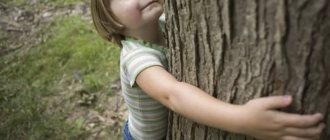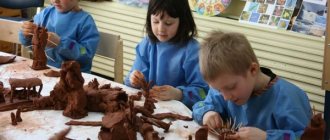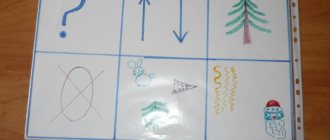Organization of environmental education at school
Organization of environmental education at school
Environmental problems that have become global affect people, every social group, and humanity as a whole. In my opinion, the solution to environmental problems depends not only on the development of science and technology, but also, first of all, on the level of human responsibility for the state of the natural environment. Experts note that modern man is not prepared for such responsibility, for the level of requirements required by the state of the environment. Ecology is an interdisciplinary science by nature; it is considered during the study of botany, zoology, chemistry, physical and economic geography, social science and other sciences. Therefore, environmental education is a continuous process that promotes awareness by each individual and society as a whole of the vital importance of the environment and the need to acquire knowledge, values, skills, experience, as well as determination, which awakens active efforts to overcome environmental problems. So, environmental education is a purposeful pedagogical activity designed to change the qualitative parameters of the attitude of man and society to the entire environment. The restructuring of individual and social consciousness is a leading factor. The understanding that a person’s fate is inextricably linked with the environment, entirely dependent on the state of nature, necessitates a radical restructuring of relationships with it: activities aimed at solving environmental problems should become the norm of human ethics. In this regard, there is a need to acquire knowledge, skills, and experience that relate to modern ecology. But versatile training does not guarantee success in business. This requires perseverance, dedication, and determination as an incentive to realize the accumulated potential. Thus, environmental education involves the development of the intellectual, emotional and volitional spheres of the human psyche, along with the improvement of its moral and ethical qualities and the stimulation of individual environmental competence. Solving an environmental problem is possible using two approaches - internal and external. The external approach provides for the possibility of identifying priority areas of activity, the development of which will significantly contribute to the reduction of environmental safety: • creation and implementation of technologies that meet environmental safety; • use of economic levers; • greening of education. A person’s professional activity is based on a certain system of knowledge, the formation of which occurs in the process of its training, so it is quite obvious that “cultivating” any specialist is impossible outside the sphere of education. But it should be noted that knowledge is neutral in relation to morality, therefore it is especially necessary to know how moral a person himself is and how he can manage his stock of knowledge. There are many examples in history of how scientific research in the hands of immoral and irresponsible people turned into a dangerous weapon. That is why the second approach to resolving the environmental problem becomes relevant - internal, which represents a person’s ethical understanding of his existence, worldview, needs, and meaning of life. The destruction of nature is a secondary process; the primary one is the violation of harmony within man himself. So, an environmental problem is first and foremost a moral problem. Therefore, environmental education carries enormous moral potential. Morality presupposes the desire for self-affirmation, spiritual development, the opportunity to realize oneself in creativity, and concern for the future.:. A person experiences the world throughout his life. The most important period in this boundless process of cognition is schooling, when the foundations of science are laid, on the basis of which a scientific picture of the world is built in the human mind. The nature of a person’s views and beliefs, his worldview and actions will depend on this in the future. That's why it's so important. so that during this period, next to the growing child there is a wise, spiritually rich and patient assistant - a school teacher. The teacher has a very important and incredibly responsible job. Our task is. is to acquaint the student with a certain branch of scientific knowledge, teach the language of his subject, the ability to use this knowledge in practical life, but also develop the best aspects of his personality, help him consciously approach the choice of a future profession, lay the desire to learn and improve the world in which we are living. Now is a special time because people are grappling with the problem of survival. And that’s why now it’s not enough to just be a subject teacher and a school teacher. Today, the teacher must become a conductor of new thinking - ecological, capable, subject to high morality, culture and professionalism, of leading humanity out of the ecological dead end. How. biology teacher, I believe that the main goal of education is that the student must first be introduced to the world of substances (both natural and man-made), laying the foundation for understanding the reasons for its diversity. to form not only general ideas about the methods of production and areas of use of substances, but also practical skills in handling them. Therefore, some time must be allocated in order to explain the harmful effects of substances on living organisms and catastrophic changes in ecosystems. This means that we should develop systematic knowledge about the chemical and biological aspects of ecology and environmental problems, which include: • knowledge about living substances; • o interactions associated with the manifestation of life in flora and fauna; • chemical relationships between organisms and the environment; • about the influence of anthropogenic factors on both man himself and all living things. To correctly assess the influence of modern civilization on the natural environment, it is necessary to identify the general patterns of the relationship between man and nature, to evaluate the results of economic activities on the earth of previous generations and social formations. Students must understand: while a person is in harmony with nature, it has almost no influence on it, but if she does not know its laws and does not take them into account in her activities, then she violates this harmony, becomes alienated from nature, thereby causing significant harm to herself and environment. We see that studying ecology in the school course is mandatory. Before this, the student must be prepared in elementary school. At the initial stage (grades 1-4), students receive basic concepts about living and non-living nature. And in high school they receive more advanced concepts, which they study in some sections of biology, geography, chemistry, physics and law. (Environmental law is an independent branch of law that unites a set of environmental legal norms that regulate social and environmental relations in order to protect the life and health of citizens, protect their environmental rights, rationally manage natural resources and ensure environmental quality in the interests of all generations). I believe that teachers must first of all form a personality who will accept the ideology of a healthy lifestyle and the preservation of their physical health. And for this we need to change our worldview, realize our responsibility to prepare an environmentally educated younger generation. , So what is “ecology”? This word translated from Greek means “the study of the house,” “housekeeping.” However, ecology is not only a science, but first of all a person’s understanding of the world, as it implies a conscious attitude towards everything that exists and the formation of an ecological culture of each member of society. Greening the educational process is not possible without extracurricular educational work with students, the basis of which should be environmental ideology. societies with such principles; • refusal of the individual from the position of an outsider; • refusal to determine the priority of force; • refusal of confrontation with nature, gigantomania; • careful attitude towards the environment; • enriching knowledge about the beauty of the surrounding world. The basis of environmental education should be methodological approaches that activate the independent cognitive activity of students. The leading role should be given to active learning methods: discussions, role-playing games, research work, related to solving specific practical problems, excursions, etc. All these methods give schoolchildren a wealth of solid knowledge that they have gained as a result of personal experience.
Well-constructed business games, close to real life, reflect socio-economic problems of environmental protection; reveal contradictions between the development of the national economy and nature. A properly organized experiment plays an important role. To meet the requirements of scientific research, it must be based on local practical problems, for example, identifying the types of pollutants in the natural environment of a certain area. Since very little time is allocated to environmental lessons, we must use extracurricular time. Our school conducts various educational activities related to environmental education. These include various evenings and discussions. Our children take an active part in various school and regional competitions. In addition, our students are engaged in landscaping the school, classrooms and their village. Some children are interested in growing flowers and studying their condition in various living conditions. During the year, the children visited the zoo and the natural museum, where they were able to get acquainted with various species of animals that live in different areas of our planet and have different living conditions. Such work allows the teacher to expand children's knowledge about the world around them, about the environment in which we live. Children can freely express their thoughts and argue when solving any environmental problem, because they notice all the shortcomings of adults, for example, throwing garbage in the wrong place, which is historical. Our rural children live in a fairly clean environment, so when they get to the city, they immediately draw conclusions about the state of the air. After all, our air is sharply different from the city air, which has many unfamiliar, unpleasant odors. In this case, it is necessary to pose a problematic question: why is this so? Children will be interested in finding sources of pollution in this area. I believe that the teacher’s task is to skillfully use what surrounds us: objects, situations, the environment. Then children will be interested in working and finding answers to certain questions, because they are directly related to life. Only in harmony with nature can a person be spiritually rich. She is our companion of joys, creativity and inspiration. The beauty of nature leaves no one indifferent. Therefore, to cultivate environmental consciousness, teachers can use different methods - biology weeks, various extracurricular educational activities and experiments, biological quizzes that stimulate the child to think, and also use additional scientific literature to find the correct answer to the question posed, and students are given grades for the completed work, which is an incentive to work independently and solve problems. Therefore, to study ecology in school it is necessary to use various teaching methods. Children must understand that our future depends on their activities. The environmental problem relates to entrepreneurial competence, which presupposes the ability to correlate one’s own economic interests and needs with available material, labor, natural and economic resources, the interests and needs of other people and society, to apply technologies for monitoring resources and ensuring sustainable development. We are faced with the task of raising a person with ecological thinking, that is, establishing a relationship in the “man-nature” system in nature itself. To adjust and form environmental consciousness, you can use psychological principles: • organize direct communication with the natural world; • organize practical participation in environmental forms of activity - youth clubs, environmental actions; . • use environmental situations, activities, and business games in teaching in accordance with the age characteristics of students. But it must be remembered that it is impossible to educate a person’s environmental consciousness on the basis of scientific information alone; for this it is necessary to use various works of art. These can be musical and literary works. It is necessary to cultivate empathy for a natural object, to form a subjective-moral attitude towards natural objects in the process of activities aimed at the natural world, mastering its appropriate strategies and technologies. I believe that what is important in pedagogical practice is a combination of methods aimed at organizing and coordinating the activities of students, as well as methods that stimulate the improvement of individual pedagogical competence.
EXAMPLE OF BIOLOGY QUIZ (for middle school students)
1. Which tree leaves turn red in autumn? (Rowan berries, aspens, maples) 2. It is known that there are many predators among animals. Can this be said about some plants? (It is possible. These plants include sundew and fluffy grass. Mosquitoes and midges land on sticky leaves and, gathering in the bubbles of these plants, die.) 3. The law and hunting rules prohibit hunting fur-bearing animals in the spring. What is the reason for this? (In the spring, fur-bearing animals molt, lose their thick, warm undercoat, and this depreciates the value of the fur. During this period, they hatch their babies.) 4. Where is it more convenient for a hare to run—from the mountain or down the mountain? (Downhill, because the hare's front legs are short and the back legs are long and are carried forward when running) 5. Why do chickens, turkeys and some granivorous birds swallow small pebbles? (Stones help digest grain.) 6. How does a cross spider know that prey has entered its web? (He holds with his paw a tightly stretched web, which is attached to the net at the other end.) 7. Which fish does not move very well on its own and how does it compensate for this? (Sticked, it sticks to other fish, as well as objects that float in the sea.) 8. On which tropical and subtropical plants can you see buds, flowers and fruits at the same time? (On citrus, cocoa, bread and melon trees) 9. Why can you see young fir trees under pine trees in the forest, but you can’t see pine under spruce trees? (Pine cannot grow under a shady spruce because it is a light-loving plant.) 10. Which forest is noisy and which is rustling? {In a deciduous forest a rustling is heard, and in a pine forest there is a noise 11. Why are the leaves from the tops of the trees the last to fall (Because they are younger) 12. Which coniferous tree sheds its needles for the winter? (larch) 13. Why is it difficult to cut a log across and relatively easy to cut along? (If we cut across, we have to cut the walls of the vessels, and when along, we separate one group of vessels from the others.) 14. How can you brush your teeth in the forest without toothpaste? (Crushed charcoal, crushed with dry mint leaves) 15. The wood of which trees is used to make paper and artificial silk? (Pines, spruces) 16. Why are night flowers white? (They are more visible to pollinating insects) 17. Why does dew form so intensively on the grass? (Grass on a clear night cools down greatly. Air vapor, in contact with cold grass, condenses and turns into a liquid state. In addition, plants evaporate water. And vapor at night
in the air they settle on the grass, looking like dew) 18. Why does the dust on the road and on the fence darken after rain? (Because water displaces air from the spaces between dust particles and wood) 19. Why does someone who bathes feel cool when they come out of the water? (Water from the surface of a person’s body, which was bathed, begins to evaporate, and the heat of our body is used for evaporation.) 20. Name the trees and shrubs that grow in our area?
INTELLECTUAL GAME “LUCKY CHANCE”
Target
: to teach students to think independently, to develop interpersonal communication skills under the motto “One for all and all for one,” to cultivate a love for their native nature and respect for it.
. Equipment
: a variety of paintings and photographs depicting nature, an exhibition of fiction and scientific literature on environmental topics. drawings by students. This educational event is designed for high school and is aimed at developing initiative, creative activity of students, expanding and deepening knowledge of ecology, and developing the intellectual development of the individual.
ь works of art We are forming two mixed teams from students in grades 10 and 11. They receive homework - prepare four questions for the opposing team and come up with a name for their team with a drawn emblem.
Teacher.
Good afternoon, dear guests. Today we will watch the intellectual game “Lucky Chance!” Its goal is to expand knowledge on ecology. And for this we invite our participants. Let's get to know our players. (Captains represent their teams.) The game is a game, and therefore the atmosphere should be good. May you all have good luck. (Represents the jury.)
Game 1 “Further, further”
Questions for the first team
1. Adaptations for feeding Butterflies.
(Proboscis) 2. A painting depicting nature. (Landscape) 3. A bird that can hang motionless in the air and fly tail first) 4. Biological active substances (Vitamins) 5. What occurs in the event of a significant accumulation of carbon dioxide and other gases in the atmosphere. (Greenhouse effect) 6. Which of the plants in our area is called a compass of plants? (Compass lettuce) 7. Who appears earlier in the spring - insects or bats? (Insects) 8. Which grass is the tallest? (Bamboo) 9. Adaptation of organisms to environmental conditions. (Adaptation) 10. A collection of individuals of the same species that live for some time in some part of the range. (Population) 11. Generalized name for a collection of animals in a certain territory/(Fauna) 12. What reptile lives on land and in water? (Crocodile) 13. A gas shell located above the surface of the lithosphere and hydrosphere. (Atmosphere) 14. No one is scared, but everything is trembling. (Aspen) 15. The type of existence of different species from which they receive mutual benefit. (Mutualism) Questions for the second team
1. What insects are called domestic? (Bees, silkworms) 2. The basic unit of structure of living organisms. (Cell) 3. Constant transformation of substances in nature. (Cycle of substances) 4. Redox process in plants. (Photosynthesis) 5. The science of the relationship between living organisms and their communities among themselves and their environment. (Ecology) 6. What substance that provides thermal conductivity is not found in the desert? (Water) 7. Restoration of damaged organs. (Regeneration) 8. Organisms that live at the expense of another organism. (Parasites) 9. Which animal does not drink water at all? (Koala) 10. Why is a titmouse called a titmouse? (That’s why she sings “xin-xin”) 11. A generalized name for a collection of plants in a certain area. (Flora) 12. Natural area that is protected by law. (Reserve) 13. External part of the wood. (Bark) 14. What animals sleep with their eyes open? (Fishes do not have eyelids, snakes have fused eyelids) 15. One of the largest common phenomena in nature. (Seasonal frequency) After the end of the game, the jury sums up the results. . .
Game 2 "Troubles"
(You can use lotto barrels for this.)
Teacher
.
I propose that the team remove the first “problem”... Question
1. What covers the top of the tooth crown? (Enamel) 2. Why do jackdaw birds sit on horses, cows, and sheep in the spring? (Birds pluck fur from animals to build nests.) 3. What gives plants their green color? (Chloroplasts) 4. The totality of all biogeocenoses of the Earth, the only global ecosystem of the highest order. (Biosphere) 5. The process of self-development of biogeocenoses, which occurs due to the interactions of living organisms with each other and the environment. (Succession) 6. What organisms are capable of synthesizing organic substances from inorganic ones? (Autotrophs) 7. Which plant is called “The Herb for 99 Diseases”? (St. John's wort) 8. Which of the sea inhabitants has the highest intelligence? (Dolphins) 9. Reduction of the upper fertile layer as a result of erosion by water. (Erosion), 10. Why is it forbidden to burn leaves in the fall? (A large amount of harmful substances accumulate in the leaves)
Teacher. It was very interesting to hear your answers to the questions proposed.
Game 3 “You give me - I give you”
Each team prepared four questions (Summing up)
Game 4 “Race for the Leader”
The teams take turns answering the questions posed.
They have 10 seconds to prepare an answer. Question
1. Transparent plastids, which are found in roots, taproots and bulbs (Leukoplasts); 2. The properties of organisms to reproduce similar to themselves. (Reproduction) 3. What is formed when a drop of resin falls into the sea? (Amber), 4. What color is a fern flower? (Ferns do not have flowers.) 5. Reactions of organisms to changes in photoperiod. (Photoperiodism) 6. What is the earth's crust called? (Lithosphere) 7. Animals in which there is no division into males and females. (Hermaphrodites) 8. What process occurs in plants in the presence of light? (Photosynthesis) 9. Science that studies the state of the environment. (Ecology) 10. This vegetable contains a large amount of vitamin A. (Carrots) 11. Components of the environment that affect living organisms and their groups. (Environmental factors) 12. The smallest flowering plant. (Duckweed) 13. Which modern bird has the largest wingspan? (Albatross) 14. A substance without which the life of organisms is impossible. (Water) 15. The state of organisms in which there are no noticeable manifestations of vital processes as a result of a weakening of metabolic processes (Annabiosis) 16. What protected areas exist? (Reserves. Wildlife sanctuaries. National parks. Botanical gardens, zoos);
Game "Report"
Compose a short report “How to build an environmentally sustainable society”
After this competition, the jury sums up the results and awards the winners
Teacher
. Thanks to the teams for participating in our game. I would like to end our meeting with these words. In nature, everything is everyday and festive, And strange, and ordinary and simple. There is a meaning in a leaf, There is a meaning in a bird's language, In everything that has withered and bloomed, Everything mysterious, hidden, visible Whispers to me: love, live! And the wind plays with blue eyes on the rays of green grass. ... And I hear the word ripening in my heart, And the fern of my hopes... In nature, everything is everyday and festive, Or maybe, simply put, sacred!
I recommend to all those who are interested in the topic of nature conservation and environmental ecology to watch the exhibition of books on environmental topics and take part in the quiz. Thank you for your attention, see you again!
ECOLOGICAL PROJECT “THE WORLD AROUND US”
There is a picture drawn on whatman paper that consists of five circles. 1. A circle with the image of a person crying, 2. A blue circle with an applique depicting dark gray microbes 3. The circle is white with arrows and spirals of different colors. • . 4. The circle is bright blue, with figures on it that resemble black blots. 5. The circle is green, with square appliqués on it. diamonds, circles, under them - rare plants, animals of the Crimea..
This project is designed for middle school students and can be carried out by high school students. Purpose
: to cultivate a love for the nature of the native land. love of beauty, promote the intellectual development and creativity of children; cultivate an ecological culture and develop systems of thinking
High school student
. Friends, today we have a very interesting lesson. Look at the blackboard. What you see is a newspaper, but nothing is written on it. This newspaper is called “The Light Around Us.” This unusual newspaper is alive. Each circle of it is a page. And it was prepared by high school students
. They will explain to us what is depicted in this newspaper. Your homework was to create drawings about the nature that surrounds us. All of them can be seen at our exhibition. Now look at the center of the circle. What is shown here? {Sad man) Why do you think he is sad? {Children's answers.) We have now heard a large number of versions, but our correspondents have prepared stories about what is drawn around our man. Then we will know and understand why he is sad. 1st correspondent
. I'll tell you about this blue field. (Points to the newspaper.) But first you have to guess what it will be about.
It passes through us into our chest. And the way back is on the way, He is invisible, and yet. We cannot live without him.
That's right, we're talking about air. We live in an ocean of air called “atmosphere.” Maybe someone knows poems or riddles about the sky? (If the children know, then they recite poems or ask riddles.) Higher than the sky, higher than the mountains, a carpet is spread. It is always, always spread out over you and over me, Sometimes it is gray, sometimes it is blue, sometimes it is bright blue. All living organisms breathe air, so it must be clean. But the air is not always like this. Did you know that it contains microbes - very small living organisms. Among them there are those that can cause various diseases, such as influenza and tuberculosis. When there are many people in a room and the windows are closed, a large number of germs accumulate. Dust, which contains a large number of microbes, settles on all objects. What do we need to do with them so that there are fewer of them in our apartment? (Children's answers) We ventilated the room, wiped off the dust with a damp cloth - removed germs from the blue field. (A student removes microbes from a blue field.) But we must remember: in order to feed and clothe ourselves, a person uses land resources. And if the land is not used properly, the soils are destroyed. and plants and animals die out. Nowadays, the air is polluted by industrial enterprises, vehicles and heating systems. Where means that large cities should have a large number of plants, since they purify the air well. And our task is to preserve green plants. (If you wish, you can talk about the dangers of burning leaves.) High school student.
You see, we made the correct explanation of how to destroy germs, and our field became clean and blue.
If you and I manage to clear all the fields, then our man will smile. The next page of our newspaper contains some strange images. Let's listen to the next correspondent and find out what is hidden under these images. 2nd correspondent:
How many of you like to listen to songs and music? Almost all of us have favorite singers or groups. In one song there are these words: without fail every morning
I turn on the TV, and, of course, the loudspeaker, and also the tape recorder.
Funny? Certainly. Why do the neighbors tell her:
Hey, citizen at the window, you are not alone in the house. Why should the whole house listen to this thunder? (Children's answers) They don't like it because it is very noisy and unpleasant. Noise is an environmental pollutant, with modern trucks, planes and other vehicles making noise so loud that it can make people sick. And very loud music causes noise intoxication and acts like a drug. Therefore, it is very harmful to turn on the tape recorder for a long time and at full strength. Some children like to “laugh” - clap their hands loudly or kick their friend’s ear. This very sharp and strong sound is dangerous because it can destroy your hearing aid. You see how many sound pollutants are around us. Some are harsh and loud. Others are waves of music, calm speech. Pleasant, soft music and calm conversation create sound comfort. What can be done to ensure sound comfort both at home and at school? {Children's answers) Do not play loud music, do not shout - in such
the image can be preserved by your hearing. And we will remove the arrows from the white field and leave beautiful waves. High school student.
You and I have already made two fields clean, and now let’s move on to the blue page of our newspaper.
Our correspondent has the floor. 3rd correspondent
You can’t wash yourself, you can’t get drunk without water, A leaf can’t bloom without water.
Birds, animals and people cannot live without water. And that’s why everyone always needs water everywhere! This page, as you understand, is about water. Where is the most water on Earth? (Children's answers) Where else is the water? In the seas, rivers, streams. Snow is also water, and clouds are water. Water is part of the soil and living organisms. What does ocean water taste like? And to drink and wash, you need fresh water and it must be clean. What kind of water are we talking about? Water, water, Wash my face, So that my cheeks turn red, So that my eyes sparkle, So that my mouth laughs, So that my teeth bite. Indeed, these words are about clean water. It is impossible to wash your face with dirty water. There is not very much fresh water on our planet, so it must be conserved. How exactly? (Children's answers) Firstly, use it sparingly, do not leave the taps open, because there is only one drop of water. What falls from a tap in one second turns into three tons of wasted water in a year. Secondly, protect water from pollution. Look at the blue field - there are stains of pollution on it. People often throw various garbage into rivers, streams, and lakes and wash their cars in them. And a lot of dirt gets into the water from factories and factories. Children, can you and I make this field clean so that a person smiles? (Children's answers) We need to save water, not throw garbage into rivers and lakes, and not wash cars. creeks, build special treatment facilities. We hope that when you become adults, you will learn how to clean up waste from factories and factories, and also treat drinking water with care. Now let’s remove all the dirty spots. High school student.
Look how clean and beautiful the field has become - clean.water!
And then our green page, from which we will learn how to preserve our green treasure. 4th correspondent
. The green page of our newspaper is a page of life. Why is she green?
(Children's answers) - It is green because the basis of living nature is plants, which provide food and oxygen to all living organisms. They are called the lungs of our planet. Every year the area of green forests that need protection decreases by 2%. People are mindlessly destroying their lungs, and thousands of animal and plant species are now at risk of extinction. Extinct species cannot be restored
Live in this green world
Good in winter and summer. Life flies like a moth, Runs like a nimble animal, Whirls like a bird in the clouds, Jumps through the branches like a marten, Life is beautiful, life is all around, Man is nature’s friend. Does a person always treat nature as a friend? (Student answers) Look at this field, there are black circles, squares, diamonds on it, under each of them there are plants or animals that are protected because there are very few of them left. We can remove these figures if we learn to behave correctly in nature. Under these circles are beautiful plants. What rules of behavior in nature do we need to know so that there are many plants with beautiful flowers, so that they delight us with their bright colors? (Children's answers) That's right, don't pick flowers, don't collect bouquets in the wild, don't weave wreaths. Beautiful flowers should be admired, not destroyed. We will remember this rule and can remove the black circles. Look how these drawings decorate our page, like plants decorate nature. But our field is spoiled by black squares, under them there are animals that have especially suffered from humans. What are we going to do? How to remove black squares? (Children's answers) The main rule is not to catch any animals, not to scare them, not to scream in the forest, not to touch birds' nests. The most important thing is not to touch or offend even the smallest bugs, spiders and worms. Let's remember this rule. Let's remove the black squares and our field will become green and beautiful. High school student
. Under these squares are animals that have suffered more than others: butterflies because of beauty, birds of prey because of a misunderstanding of the role of predators in nature, and toads because of that. that they don't like their appearance. This green field is the most beautiful. And we were not able to talk about all the plants and animals that need protection. But if we know the rules of behavior in nature. then we will help all living organisms. And now. look . Our man and our newspaper have a completely different look. The man smiles, he feels very good. (We remove the man’s gloomy face, a face appears that smiles) Our man feels very good in a clean environment, he is healthy, Human health is also the wealth of nature, and his must be saved. Your homework is to write an essay on the topic “How I see my planet.” You will receive grades for this work. Now let's solve the riddles. This is an old friend of ours: he lives on the roof of a house - long-legged, long-nosed, long-necked, voiceless. He flies to hunt for frogs in the swamp. (Stork) She welcomes spring and puts on earrings. A green scarf is draped over the back. And the striped dress. You know it - this is... (Birch tree) Hard-working animals are building a house in the middle of the river. If anyone comes to visit, Know that they are coming out of the river. (Beavers) Thank you very much. I hope you understand what is needed to keep the field clean.
The student who authored the best work receives a gift.







